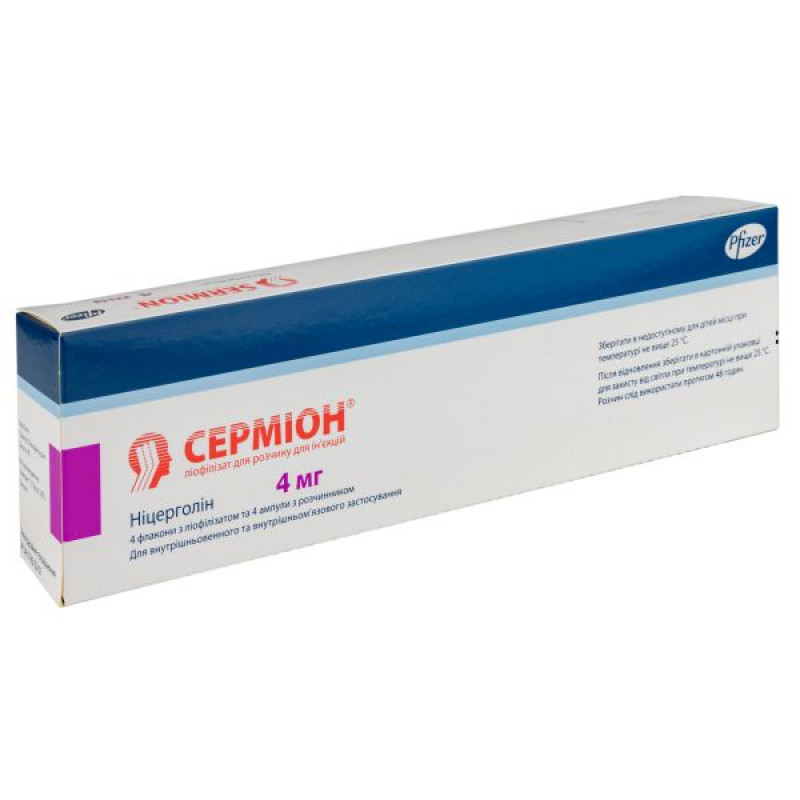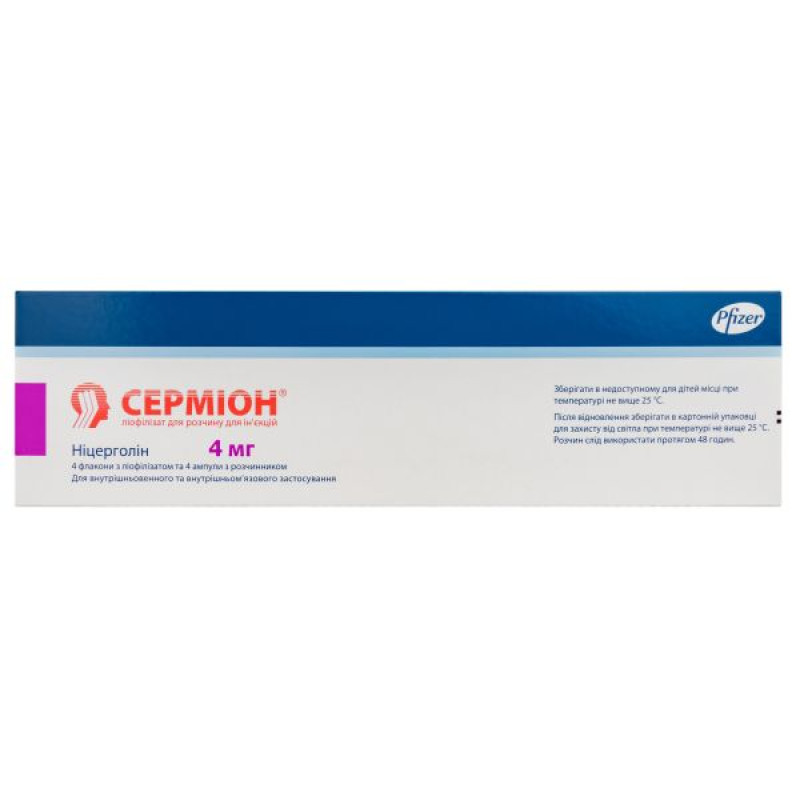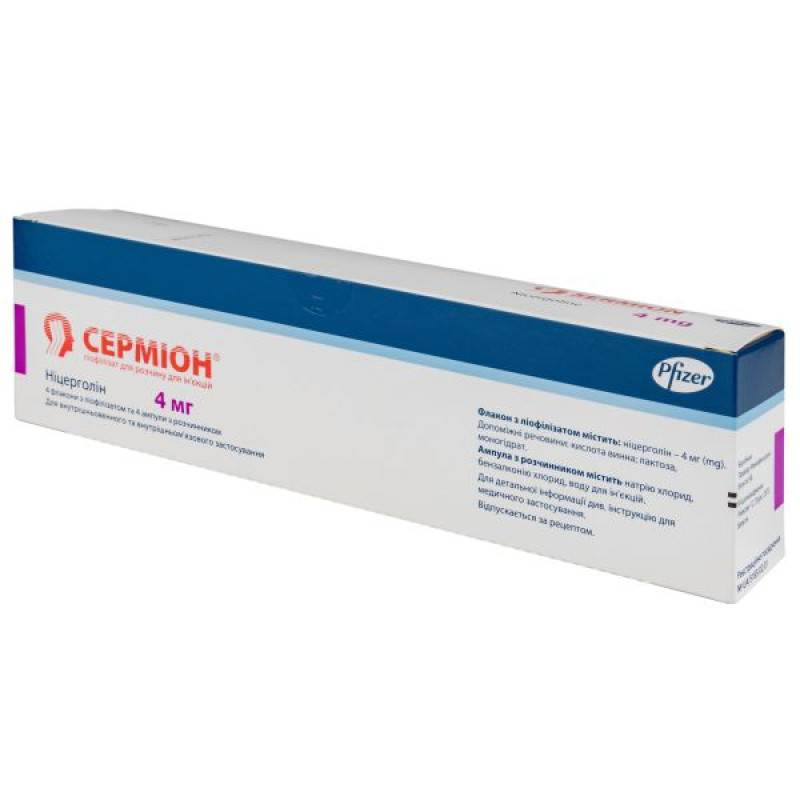Sermion lyophilized powder for preparation of solution for injection 4 mg vial with solvent in ampoules 4 ml No. 4

Instructions Sermion lyophilized powder for preparation of solution for injection 4 mg vial with solvent in ampoules 4 ml No. 4
Composition
active ingredient: nicergoline;
1 vial contains 4 mg of nicergoline;
excipients: lactose monohydrate; tartaric acid;
solvent: sodium chloride, benzalkonium chloride, water for injections.
Dosage form
Lyophilisate for solution for injection.
Main physicochemical properties: porous white lyophilisate.
Pharmacotherapeutic group
Drugs affecting the cardiovascular system. Peripheral vasodilators. Ergot alkaloids. Nicergoline. ATC code C04A E02.
Pharmacological properties
Pharmacodynamics
Nicergoline is an ergoline derivative with alpha-1-adrenergic blocking activity when administered parenterally. After oral administration, nicergoline undergoes rapid and extensive metabolism to form a number of metabolites, which also exert activity at various levels of the central nervous system.
When administered orally, Sermion® exhibits numerous neuropharmacological effects: it not only increases glucose uptake and consumption in the brain, enhances protein and nucleic acid biosynthesis, but also affects various neurotransmitter systems.
Sermion® improves cerebral cholinergic functions in old animals. Long-term administration of nicergoline in old rats prevented the age-related decrease in acetylcholine levels (in the cerebral cortex and striatum) and reduced acetylcholine release (in the hippocampus) in vivo. After long-term oral administration of Sermion®, an increase in choline acetyltransferase activity and muscarinic receptor density was also observed. Moreover, in both in vitro and in vivo studies, nicergoline significantly reduced acetylcholinesterase activity. In these experimental studies, neurochemical effects were observed simultaneously with a stable improvement in behavioral responses. For example, in the maze test, mature animals treated with Sermion® for a long time developed responses similar to those in young animals.
Sermion® has also been shown to reduce cognitive impairment induced by several agents (hypoxia, electroconvulsive therapy (ECT), scopolamine) in animals. Oral administration of Sermion® at low doses increases dopamine metabolism in adult animals, particularly in the mesolimbic region, likely by modulating dopaminergic receptors. Sermion® improves the mechanisms of intercellular signal transmission in adult animals. Both after a single and long-term oral administration of the drug, an increase in basal and agonist-sensitive phosphoinositide metabolism was observed. Sermion® also increases the activity and translocation to the membrane site of calcium-dependent isoforms of protein kinase C. These enzymes are involved in the mechanism of secretion of soluble amyloid precursor protein, which leads to increased release and reduced production of pathological beta-amyloid, which was demonstrated in human neuroblastoma culture.
Due to its antioxidant effect and ability to activate detoxification enzymes, Sermion® prevents nerve cell death due to oxidative stress, and also prevents the occurrence of apoptosis in in vivo and in vitro experimental models. Sermion® attenuates the age-related decrease in neuronal nitric oxide synthase mRNA expression, which may also affect the improvement of cognitive function.
Pharmacodynamic studies in humans using computerized electroencephalogram (EEG) techniques were conducted in young and elderly volunteers, as well as in elderly patients with cognitive impairment. Nicergoline had a normalizing effect on EEG results in elderly and young adults under hypoxia, increasing α- and β-activity and decreasing δ- and θ-activity. Positive changes in evoked potentials and responses to stimuli were recorded in patients with mild to moderate dementia of various etiologies (senile dementia of the Alzheimer's type and multi-infarct dementia); after long-term treatment with nicergoline (2-6 months), these changes correlated with improvement in clinical symptoms.
In view of the above, it is clear that nicergoline acts by modulating a wide range of cellular and molecular mechanisms involved in the pathophysiology of dementia.
Double-blind, placebo-controlled clinical trials included more than 1,500 patients with dementia (Alzheimer's, vascular, and mixed types) who received nicergoline at a dose of 60 mg per day or placebo. After long-term treatment with nicergoline, a continuous reduction in cognitive and behavioral impairments associated with dementia was observed. Changes were observed after 2 months of treatment and were maintained for one year of treatment.
After administration of 2 mg of H3-nicergoline to three healthy volunteers by intravenous infusion over approximately 10 minutes, nicergoline underwent rapid hydrolysis of the ester bond to form the metabolite 1-methyl-10-methoxydihydrolysergol (MMDL). Subsequent loss of the methyl group at position 1 of the ergoline structure results in the formation of the major metabolite, 10-methoxydihydrolysergol (MDL). Unchanged nicergoline was detected in all three patients for up to 90 minutes after infusion with a mean plasma level of approximately 4.5 ng/ml at 20 minutes followed by a rapid decline associated with a half-life of less than 30 minutes. The maximum concentration of MMDL was observed as early as 20 minutes after administration, and its levels declined rapidly thereafter for up to 8 hours. The maximum concentration of MDL was about 2.2 ng/mL 4 hours after the end of the infusion, followed by a slower decline phase than that of MMDL. Approximately 50% and 10% of the administered radioactivity were excreted in the urine within 4 days and in the feces within 7 days, respectively.
Special patient groups.
The effect of renal impairment on the pharmacokinetics of nicergoline was evaluated in patients with mild (CLcr (creatinine clearance) 60–80 mL/min), moderate (CLcr 30–50 mL/min) and severe (CLcr 10–25 mL/min) renal impairment. In patients with mild (n = 5), moderate (n = 5) and severe (n = 4) renal impairment, significant differences were observed in the amount of MDL excreted in the urine within 120 hours after taking nicergoline at a dose of 30 mg orally (38.1%, 42.6% and 25.7% of the drug dose, respectively); for MMDL, the corresponding values were 1.7%, 0.6% and 0.2%. In patients with severe renal impairment, a significant decrease in the excretion of MDL in the urine was observed compared to the other two groups. In addition, patients with mild, moderate, and severe renal impairment had a mean decrease in urinary MDL excretion (0-72 hours) of 32%, 32%, and 59%, respectively, compared to patients with normal renal function in another study when taking the 30 mg tablet.
The pharmacokinetics of nicergoline have not been studied in patients with impaired liver function.
The pharmacokinetics of nicergoline have not been studied in children.
The pharmacokinetics of nicergoline in elderly patients have not been fully studied.
Indication
Acute and chronic cerebrovascular metabolic disorders due to atherosclerosis, thrombosis and embolism of cerebral vessels, transient disorders of cerebral blood circulation (transient ischemic attacks). Headache. Additional therapy in the treatment of arterial hypertension.
Contraindication
Hypersensitivity to the active substance, ergot alkaloids or any component of the drug. Recent myocardial infarction, acute bleeding, orthostatic hypotension, severe bradycardia.
Interaction with other medicinal products and other types of interactions
The drug should be used with caution together with:
antihypertensive agents (nicergoline may potentiate their effect). Nicergoline may potentiate the effect of β-blockers on the heart;
sympathomimetic agents (alpha and beta): nicergoline may counteract the vasoconstrictor effects of sympathomimetic drugs, as it has an alpha-adrenergic blocking effect (see section "Special instructions for use");
with drugs metabolized by the CYP2D6 isoenzyme: since nicergoline is metabolized by the CYP2D6 isoenzyme, interactions with other drugs metabolized by the same pathway cannot be ruled out; with antiplatelet agents and anticoagulants (e.g. acetylsalicylic acid): nicergoline increases the effect on hemostasis, which may prolong bleeding time; with drugs affecting uric acid metabolism: nicergoline may lead to an asymptomatic increase in uric acid levels in blood plasma.
Application features
Single- and multiple-dose studies of nicergoline have demonstrated that nicergoline can reduce systolic blood pressure and, to a lesser extent, diastolic blood pressure in normotensive and hypertensive patients. This effect of nicergoline on blood pressure may vary, as other studies have not demonstrated changes in systolic or diastolic blood pressure.
Sympathomimetic agonists (alpha and beta) should be used with caution in patients receiving nicergoline (see section "Interaction with other medicinal products and other types of interactions").
Nicergoline should be administered with caution to patients with hyperuricemia or a history of gout and/or during concomitant treatment with drugs that may affect the metabolism and excretion of uric acid (see section "Adverse reactions").
The development of fibrosis (e.g., pulmonary, cardiac, valvular, and retroperitoneal fibrosis) has been associated with the use of certain ergot alkaloids that possess agonist activity at serotonin 5-HT2β receptors.
Symptoms of ergotism (including nausea, vomiting, diarrhea, abdominal pain, and peripheral vasoconstriction) have been reported with the use of some ergot alkaloids and their derivatives.
Before prescribing this class of drugs, doctors should be familiar with the signs and symptoms of ergot overdose.
Ability to influence reaction speed when driving vehicles or other mechanisms
Although the clinical effect of Sermion® is aimed at improving alertness and concentration, the effect of the drug on the reaction speed when driving or operating other mechanisms has not been studied. In any case, caution should be exercised, taking into account the patient's underlying disease.
When driving vehicles or operating other machines, it should be taken into account that dizziness or drowsiness may occasionally occur (see section "Adverse reactions").
Use during pregnancy or breastfeeding
Pregnancy
Nicergoline had no reproductive toxicity in pregnant rats and rabbits. Studies in pregnant women have not been conducted. Given the approved indications, the use of the drug in pregnant and lactating women is unlikely. Nicergoline should be used during pregnancy only if the potential benefit to the woman outweighs the potential risk to the fetus.
Breast-feeding
It is not known whether nicergoline passes into breast milk, therefore Sermion® should not be used by women who are breastfeeding.
Fertility
In a study in rats, nicergoline did not affect fertility.
Method of administration and doses
Intramuscular injections: 2–4 mg (2–4 ml) twice daily (using the supplied solvent).
Slow intravenous infusion: 4-8 mg dissolved in 100 ml of saline or glucose solution. This dose may be repeated several times a day at the discretion of the physician.
There is experience in using Sermion® by intra-arterial injection: 4 mg dissolved in 10 ml of saline, over 2 minutes.
The dosage regimen, duration of treatment and route of administration depend on the individual clinical situation. In some cases, it is advisable to start treatment with parenteral administration of the drug, and then switch to long-term oral administration.
The effect of treatment appears gradually. Since therapy is usually long-term, the doctor should assess the feasibility of continuing treatment at certain intervals, but not less than every 6 months.
Elderly patients: Based on pharmacokinetic and tolerability studies, no dosage adjustment is required for elderly patients.
Patients with renal impairment: Since urinary excretion is the main route of elimination (80%) of nicergoline and its metabolites, it is recommended to reduce the dose of the drug for patients with renal impairment (serum creatinine level ≥ 2 mg/ml) (see section "Pharmacokinetics").
Children
The safety and efficacy of nicergoline in children have not been established. No data are available.
Overdose
When using nicergoline in high doses, a temporary decrease in blood pressure is possible. Special treatment is usually not required, it is enough to lie down for a few minutes. In exceptional cases, with the development of severe insufficiency of blood supply to the brain and heart, the appointment of sympathomimetics and constant monitoring of blood pressure indicators is recommended.
Adverse reactions
Adverse reactions are listed below by system organ class and in order of decreasing seriousness. The frequency is defined as follows: very common (≥ 1/10); common (≥ 1/100 to < 1/10); uncommon (≥ 1/1,000 to < 1/100); rare (≥ 1/10,000 to < 1/1,000); very rare (< 1/10,000); not known (cannot be estimated from the available data).
Psychiatric disorders: uncommon: agitation, confusion, insomnia.
Nervous system disorders: uncommon: drowsiness, dizziness, headache; frequency unknown: feeling hot.
Vascular disorders: uncommon: hypotension, hot flashes.
Gastrointestinal disorders: common: abdominal discomfort; uncommon: diarrhea, nausea, constipation.
Skin and subcutaneous tissue disorders: uncommon: pruritus; frequency unknown: rasha.
General disorders and administration site conditions: frequency unknown: fibrosis.
Research findings: uncommon: increased blood uric acid levels.
a The frequency of adverse reactions was based on the results of studies included in the comprehensive summary of product safety (reactions that occurred after the start of treatment for any reason). This comprehensive safety analysis includes data from 8 double-blind controlled studies in patients with mild to moderate dementia, of which 1246 patients received nicergoline. The “rule of three” was not applied because there were fewer than 3000 patients in the comprehensive summary of product safety database for nicergoline.
Reporting suspected adverse reactions after the registration of a medicinal product is an important measure. This allows for continued monitoring of the benefit/risk balance of the medicinal product. Healthcare professionals are asked to report any suspected adverse reactions in accordance with legal requirements.
Expiration date
4 years.
Storage conditions
After reconstitution, store in the outer carton to protect from light at a temperature not exceeding 25°C. The solution should be used within 48 hours.
Packaging
4 mg of lyophilisate in vials; 4 ml of solvent in ampoules packed together in a cardboard box.
Vacation category
According to the recipe.
Producer
Pfizer Manufacturing Belgium NV.
Location of the manufacturer and its business address
Rijksweg 12, Puurs, 2870, Belgium.
There are no reviews for this product.
There are no reviews for this product, be the first to leave your review.
No questions about this product, be the first and ask your question.












